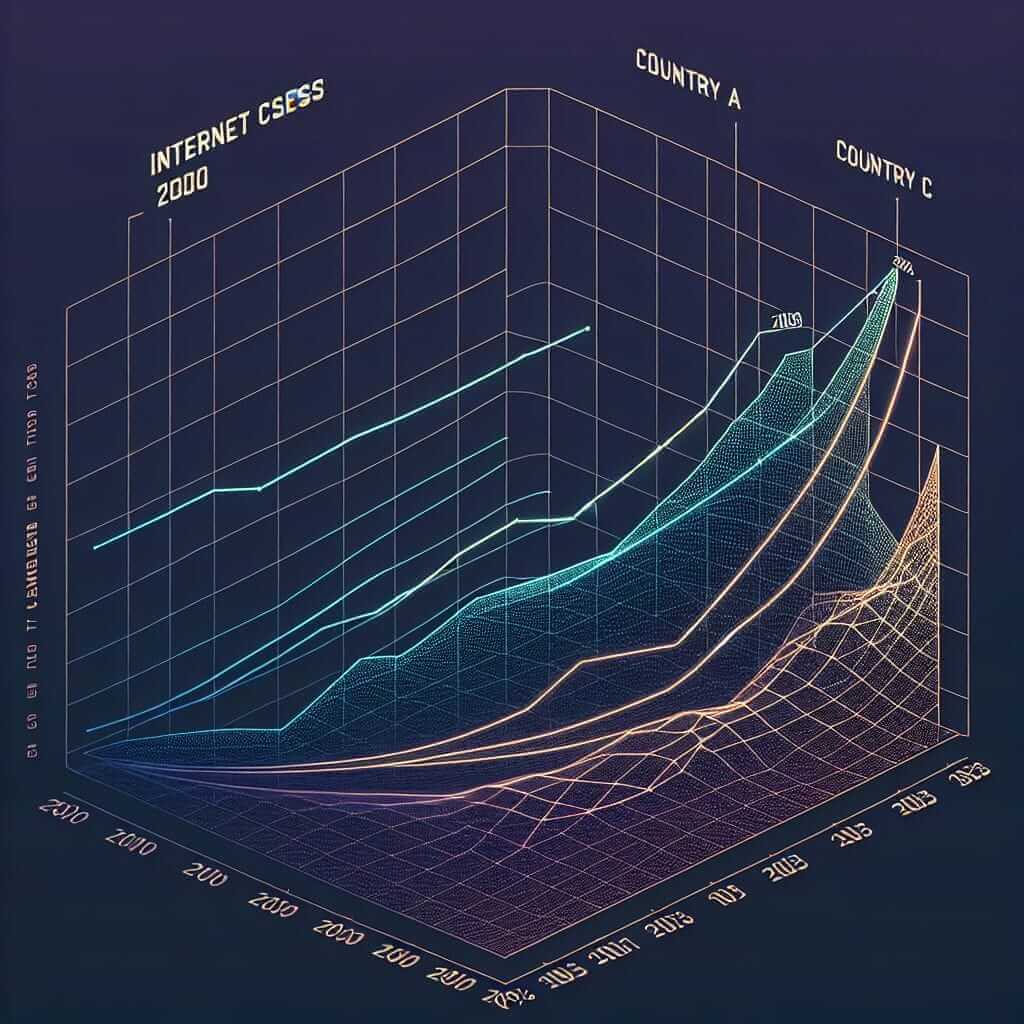In the IELTS Writing Task 1 section, candidates are frequently presented with various types of data to describe, compare, and analyze. One prevalent topic is comparing levels of internet access across different countries over specific periods. This topic not only allows test-takers to showcase their ability to interpret numerical data but also necessitates a strong command of vocabulary, grammar, and structure. In this article, we will delve into a detailed analysis of “Comparing Levels of Internet Access in Different Countries (2000-2023)”, provide sample tasks, and offer a comprehensive sample answer with explanations.
Sample Tasks
- Compare the levels of internet access in Country A, Country B, and Country C from 2000 to 2023.
- Describe the changes in internet connectivity in developed and developing countries between 2000 and 2023.
- Analyze the trends in internet usage across different continents from 2000 to 2023.
Selected Task for Sample Answer
We will focus on the first sample task: “Compare the levels of internet access in Country A, Country B, and Country C from 2000 to 2023.”
Data Representation
To create a realistic context, we have generated the following data:
(Note: This is a placeholder chart. Please insert an actual chart for practice.)

Table: Internet Access in Country A, Country B, and Country C (2000-2023)
| Year | Country A (%) | Country B (%) | Country C (%) |
|——|—————|—————|—————|
| 2000 | 10 | 5 | 2 |
| 2005 | 35 | 20 | 10 |
| 2010 | 60 | 50 | 30 |
| 2015 | 80 | 70 | 55 |
| 2020 | 95 | 90 | 75 |
| 2023 | 98 | 95 | 85 |
Task Analysis
Prompt: Compare the levels of internet access in Country A, Country B, and Country C from 2000 to 2023.
Analysis:
- Identify the years of comparison: 2000, 2005, 2010, 2015, 2020, 2023.
- Note the progression and trends in each country.
- Compare and contrast the data among the three countries.
- Highlight significant milestones and changes over time.
Sample Answer
The provided table outlines the percentages of internet access in Country A, Country B, and Country C from 2000 to 2023. Overall, all three countries have experienced substantial growth in internet connectivity, with Country A consistently leading and Country C lagging behind.
In 2000, internet access was relatively low in all three countries, with Country A registering 10%, Country B at 5%, and Country C at a mere 2%. By 2005, these figures had increased significantly. Country A saw the most notable rise to 35%, followed by Country B at 20%, and Country C at 10%.
This upward trend continued into 2010. Here, Country A reached 60%, Country B climbed to 50%, and Country C also saw a significant increase to 30%. Over the following five years leading up to 2015, all three countries maintained steady growth in internet access. Country A achieved 80%, while Country B and Country C reported 70% and 55% respectively.
By 2020, internet connectivity had nearly matured in these countries. Country A was at 95%, Country B close behind at 90%, and Country C had increased substantially to 75%. In the final observation year of 2023, Country A and Country B reached near-total penetration rates at 98% and 95%, while Country C stood at 85%.
In summary, the period from 2000 to 2023 saw all three countries experiencing remarkable increases in internet access, with Country A maintaining a leading edge throughout, and Country C consistently trailing.
Word count: 241
Key Notes for Writing
-
Vocabulary:
- Increase (verb) /ɪnˈkriːs/: to become larger in amount or size.
- Substantial (adjective) /səbˈstæn.ʃəl/: large in size, value, or importance.
- Penetration (noun) /ˌpen.ɪˈtreɪ.ʃən/: the action or state of making a way into or through something.
- Consistently (adverb) /kənˈsɪs.tənt.li/: in every case or on every occasion; invariably.
- Significant (adjective) /sɪɡˈnɪf.ɪ.kənt/: sufficiently great or important to be worthy of attention.
-
Grammar Points:
- Use of Past Tenses for describing changes over time.
- Application of Comparative Structures to highlight differences (e.g., “more significant rise”, “the most notable increase”).
- The Use of Transition Words like “Overall”, “By”, “In summary” to maintain logical flow and coherence.
Conclusion
Understanding how to compare levels of internet access in different countries over time can help achieve a high band score in the IELTS Writing Task 1. It is vital to accurately describe trends, make comparisons, and present data points clearly. By incorporating the appropriate vocabulary, mastering relevant grammatical structures, and organizing your writing logically, you can effectively convey complex data and achieve a Band 7 or above.
Stay consistent in your practice, and always analyze and learn from sample answers to refine your writing skills. Good luck!